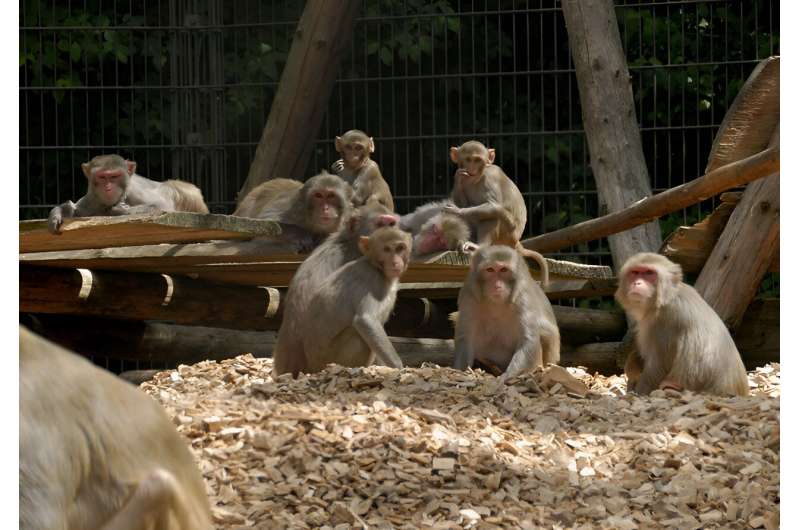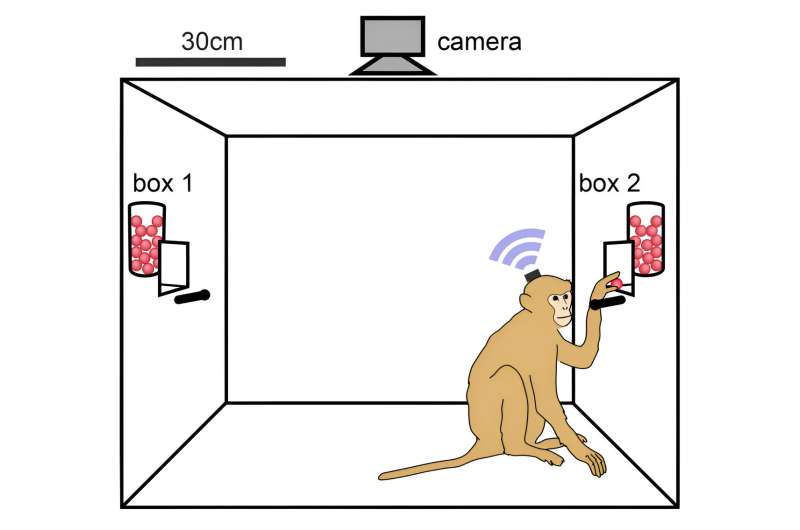This article has been reviewed according to Science X's editorial process and policies. Editors have highlighted the following attributes while ensuring the content's credibility:
fact-checked
peer-reviewed publication
trusted source
proofread
Researchers decode neuronal basis of decision-making processes to predict actions

For decades, neuroscientists have been trying to understand how we manage to make the best possible decisions. Due to technical limitations, researchers have so far had to rely on experiments in which monkeys perform tasks on computer screens while the activity of their brain cells is measured.
The animals are trained to sit still in a chair and are therefore restricted in their natural freedom of movement. Since it is now possible to wirelessly record the activity of several individual nerve cells, decision-making in scenarios with natural movement sequences can be investigated.
For the study, a team of researchers from Germany and the U.S. trained two rhesus monkeys to explore an experimental room with two button-controlled food boxes. Each time the monkeys pressed a button on one of the boxes, they had the chance to receive food pellets.
The two boxes were set in such a way that the time intervals between the individual food dispenses became longer and longer during an experimental run. The longer the monkeys waited until they pressed the button again, the more pellets they received.
During the experiment, the researchers measured the neuronal activity in the front part of the brains of the two monkeys and decomposed it with the help of a mathematical model. By decoding monkeys' reward expectations from the neural activity, they were able to predict how long the rhesus monkeys were willing to wait for a higher reward and when they decided to choose another option.
The results, published in Nature Neuroscience, advance the understanding of self-paced actions, eventually contributing to a better understanding of neurological diseases such as Parkinson's.

"When we started the experiment, we expected that our monkeys would simply choose the box based on how successful they had been with that box before," explains first author Neda Shahidi, now a junior research group leader at the Collaborative Research Center 1528 at the University of Göttingen and the German Primate Center in Göttingen.
"After a while, however, they had learned to pay attention to the time since the last keystroke and also to their previous success at a box. If they had waited a while but not received any pellets, they waited even longer before pressing the next time. However, if they were not rewarded too many times in a row after pressing the button, they moved to the other box. They had apparently decided that this food box was not worth the wait and it was better to look elsewhere."
To analyze the underlying neuronal processes, the researchers wirelessly recorded the activity of 96 neurons in the prefrontal cortex. This brain area is involved in the control of goal-directed behavior and is activated in many aspects of the foraging task, for example in the evaluation of options, the expectation of a reward, the preparation of actions, and the perception of the outcome.
"However, characterizing the activity patterns of individual neurons does not always reveal the whole story when we study complex decision-making processes," Shahidi explains. "Complex behaviors consist of different components that are sometimes processed simultaneously in the same brain area."
To separate these components, the researchers developed a mathematical model that first identified components of neural activity, mainly consisting of groups of neurons that were more strongly active when the animals waited longer before pressing a button or when the button was more rewarding in the last few presses. Since the animals cannot know in advance whether a button press will be rewarded, the researchers assume that these neurons represent the animals' subjective expectations.
The researchers also tested whether the neuronal activity could be used to predict when the animals would press the button and whether they would decide to switch between the boxes. "We were surprised at how well our model could predict what the monkeys would do in the next few seconds," says Shahidi.
"Our results show not only how the development of wireless recording technologies can improve our understanding of brain mechanisms in natural movement scenarios, but also how advances in data science are transforming neuroscience by extracting the computational components of the brain from the collective activity of neurons. We hope that in the long term, such advances will help to better understand abnormalities in cognitive processes such as self-pacing in Parkinson's or self-initiating actions in apathy," says Shahidi.
More information: Neda Shahidi et al, Population coding of strategic variables during foraging in freely moving macaques, Nature Neuroscience (2024). DOI: 10.1038/s41593-024-01575-w





















